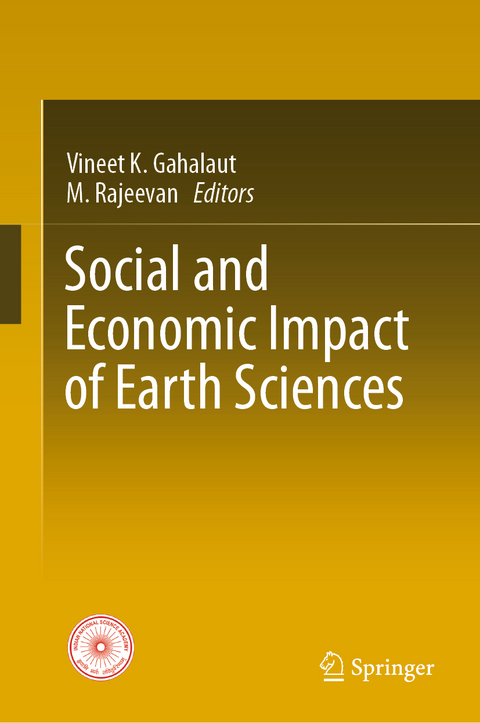
Social and Economic Impact of Earth Sciences
Springer Verlag, Singapore
978-981-19-6928-7 (ISBN)
This book collects research papers on the economic and social impact of earth sciences. It covers topics related to weather forecasting, climate modelling, monsoon variability, air pollution, heat and cold wave, deep sea mineral and living resources, ocean state monitoring, tsunami and earthquake monitoring, desalination, coastal research, etc. The book focuses on the activities of the Ministry of Earth Sciences, India, in promoting the societal and economic impacts of earth science research in a simple language and in the form of stories and case studies, so that people with basic science degree can understand them.
Vineet K. Gahalaut, Ph.D., is Chief Scientist at CSIR-National Geophysical Research Institute, Hyderabad, India. He did his masters and Ph.D. from the University of Roorkee (now IIT Roorkee) in geophysics in the year 1989 and 1995, respectively. He has also served as Director of National Center for Seismology, Ministry of Earth Sciences, New Delhi (from 2015–2019). He is involved in research related to earthquake processes, tectonic geodesy, seismology, and geodynamics. His research work mainly focusses on plate convergence, strain accumulation, earthquake occurrence processes in the plate interior and plate boundary regions of the Indian plateau. He has more than 150 research publications in peer reviewed journals and is Fellow of the Indian Academy of Sciences, Bengaluru, and Indian National Science Academy, Delhi, India. M. Rajeevan, Ph.D., is Distinguished Scientist at the Ministry of Earth Sciences (MoES), the Government of India. He did his masters and Ph.D. in physics from Madurai Kamaraj University in 1983 and from the University of Pune in 1997, respectively. He has served the Tata Institute of Fundamental Research (TIFR), India Meteorological Department (IMD), National Atmospheric Research Laboratory (NARL), and Indian Institute of Tropical Meteorology, before he became the Secretary at the MoES in December 2015. His expertise includes monsoon variability and monsoon prediction, climate change and extreme weather events. He made significant contributions in developing many application tools and prediction models for societal applications like monsoon seasonal prediction models, gridded climate data sets and climate application products for regional climate services. He has more than 150 research papers to his credit published in several peer reviewed journals. He is Fellow of all the three science academies of India and also an academician of the International Academy of Astronautics. He is an expert member in the Research Board of WorldMeteorological Organization (WMO).
Chapter 1. Short to Medium Range Weather Forewarning System in India.- Chapter 2. Operational Seasonal Forecasting of the Southwest Monsoon Rainfall.- Chapter 3. Severe Weather Events over Indian Region: Insights from Ensemble Prediction System.- Chapter 4. Monsoon Variability and Change.- Chapter 5. Use of Remote Sensing in Weather and Climate Studies and Forecasts.- Chapter 6. Forecasting of Severe Weather Events.- Chapter 7. Weather and Climate Modelling.- Chapter 8. Operational Extended Range Forecast of Weather and Climate Over India and the Sectoral Applications.- Chapter 9. Frequency and Magnitude of Heat and Cold Waves over India.- Chapter 10. Economic Impacts of Air pollution and Fog in India and Prediction Efforts.- Chapter 11. Advances in Ocean State Forecasting and Marine Fishery Advisory Services for the Indian Ocean Region.- Chapter 12. Satellite-Based Marine Ecological Services for the Indian Ocean Region.- Chapter 13. Augmentation of Water—Can Oceans Help?.-Chapter 14. Emerging Blue Economy Paradigm and Developments in India.- Chapter 15. Coastal Research—Beach Restoration and Protection.- Chapter 16. Developing Ocean Technology.- Chapter 17. Deep Sea Mineral Resources and the Indian Perspectives.- Chapter 18. Tsunami Early Warning Services.- Chapter 19. Landslide Hazard and Monitoring.- Chapter 20. Seismic Microzonation of Indian Cities and Strategy for Safer Design of Structures.- Chapter 21. Earthquake Monitoring in India by National Center for Seismology, India.
| Erscheinungsdatum | 09.01.2023 |
|---|---|
| Zusatzinfo | 12 Illustrations, black and white; XVII, 432 p. 12 illus. |
| Verlagsort | Singapore |
| Sprache | englisch |
| Maße | 155 x 235 mm |
| Themenwelt | Naturwissenschaften ► Biologie ► Ökologie / Naturschutz |
| Naturwissenschaften ► Geowissenschaften ► Geografie / Kartografie | |
| Naturwissenschaften ► Geowissenschaften ► Geologie | |
| ISBN-10 | 981-19-6928-0 / 9811969280 |
| ISBN-13 | 978-981-19-6928-7 / 9789811969287 |
| Zustand | Neuware |
| Haben Sie eine Frage zum Produkt? |
aus dem Bereich


